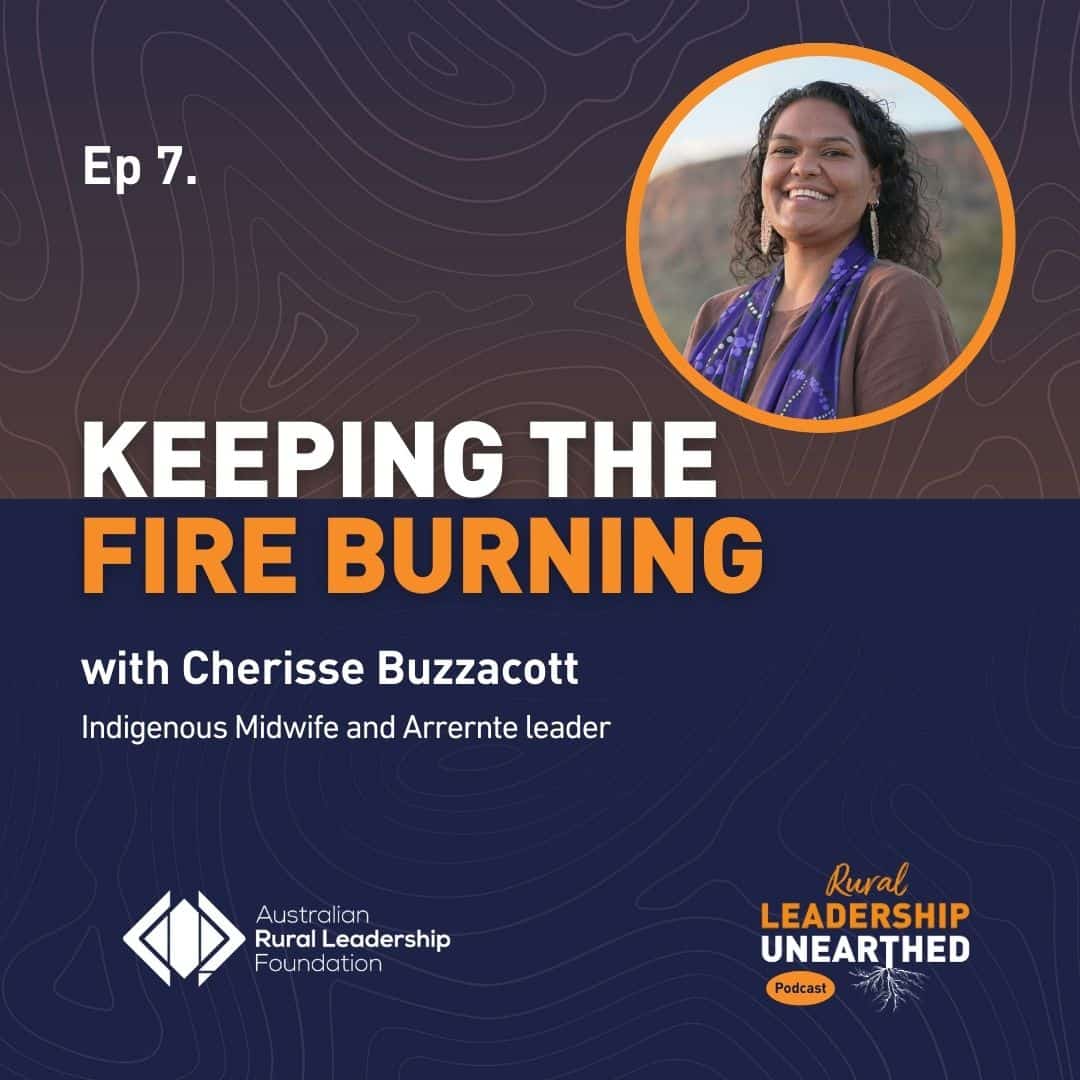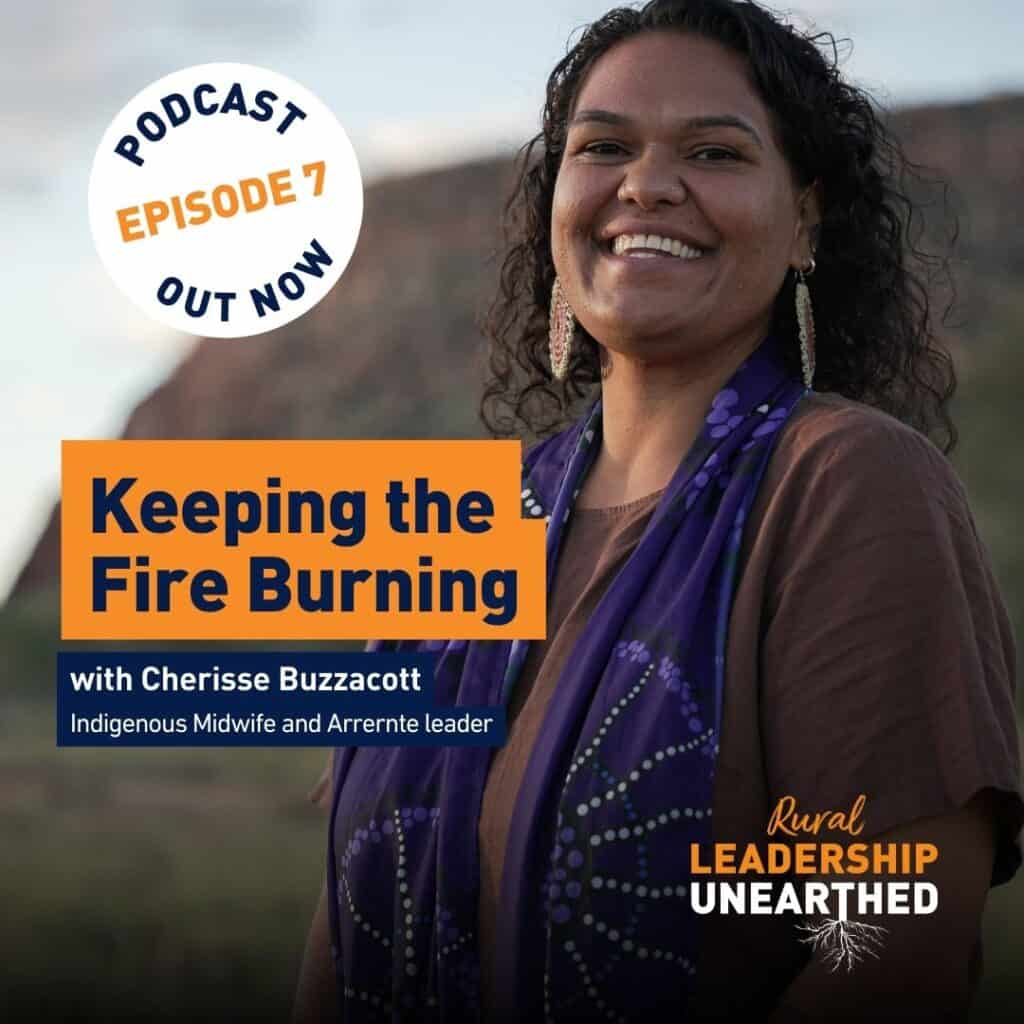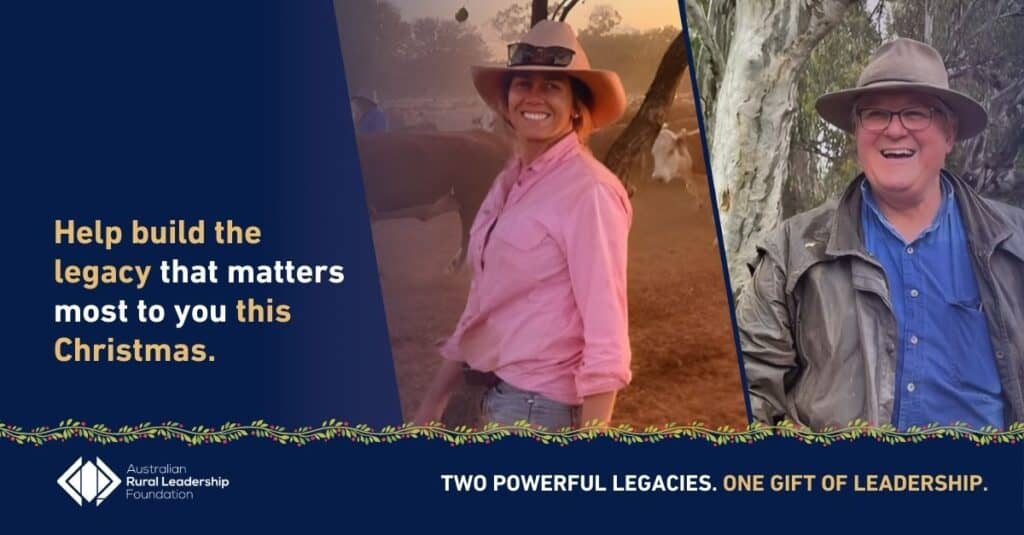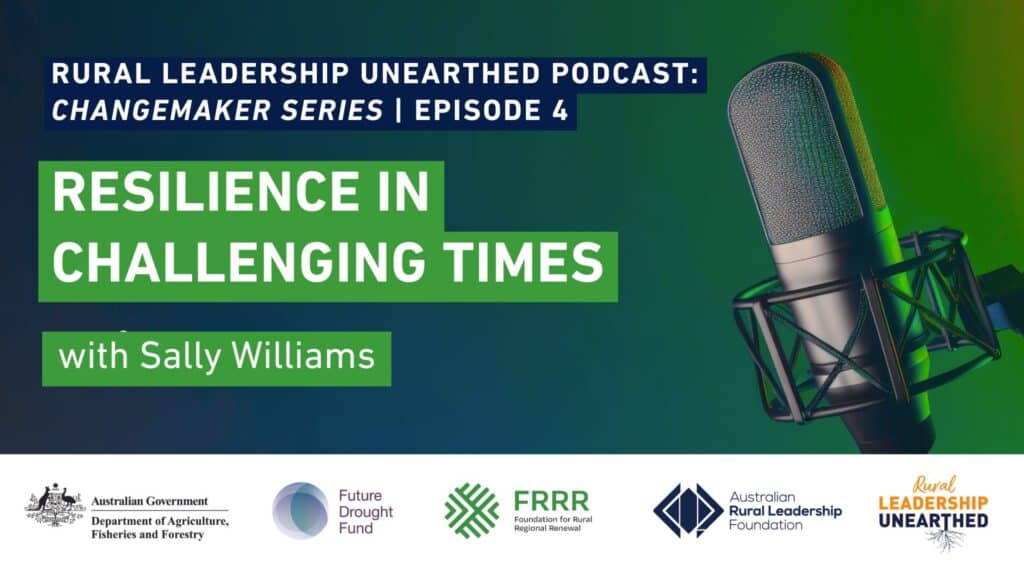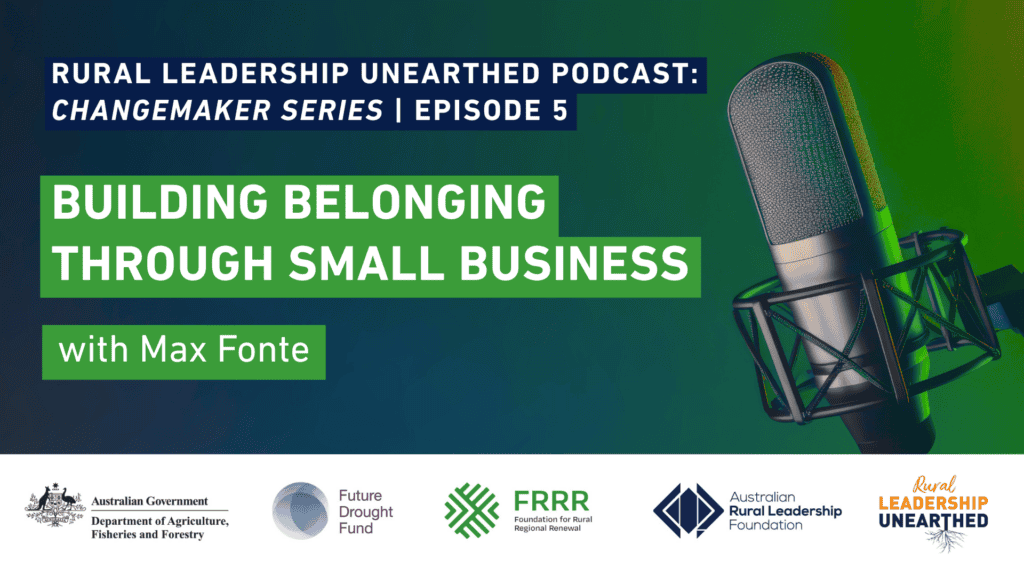Cherisse Buzzacott is a First Nations midwife and proud Arrernte woman from
Mparntwe (Alice Springs). Throughout her career, she has become a tireless advocate for systemic change, including providing access to culturally safe maternity care through the National Birthing on Country programs. Currently, she works with the Northern Territory Business Network as a Senior Policy Officer, and leads a working Board of First Nations midwives through the Rhodan the Lipsett Indigenous Midwifery Charitable Fund.
Cherisse was raised in a family where activism and speaking out is ingrained. She is passionate about supporting women’s reproductive health and shaping a strong future for her community, underpinned by connection to language and culture.
In the latest episode of ARLF podcast, Rural Leadership Unearthed, Cherisse shares her personal experience of racism and prejudice in a system that should be caring for women at their most vulnerable. Sitting down with our host, Claire Delahunty, she reflects on how this experience has fuelled her quest to achieve better outcomes for all First Nations women and birthing people. Cherisse speaks about the evolution she has experienced as a leader in the health sector; from being ‘the only’ voice on some issues, to one of a growing network of Indigenous midwives and advocates.
As we mark NAIDOC Week 2024, Cherisse – part of the National NAIDOC Committee – also speaks about the resonance of this year’s theme: Keep the Fire Burning. Cherisse is a graduate of the ARLF Milparanga Established Leaders Program, and has just embarked on Course 31 of the Australian Rural Leadership Program, thanks to a scholarship from the National Indigenous Australian Agency.
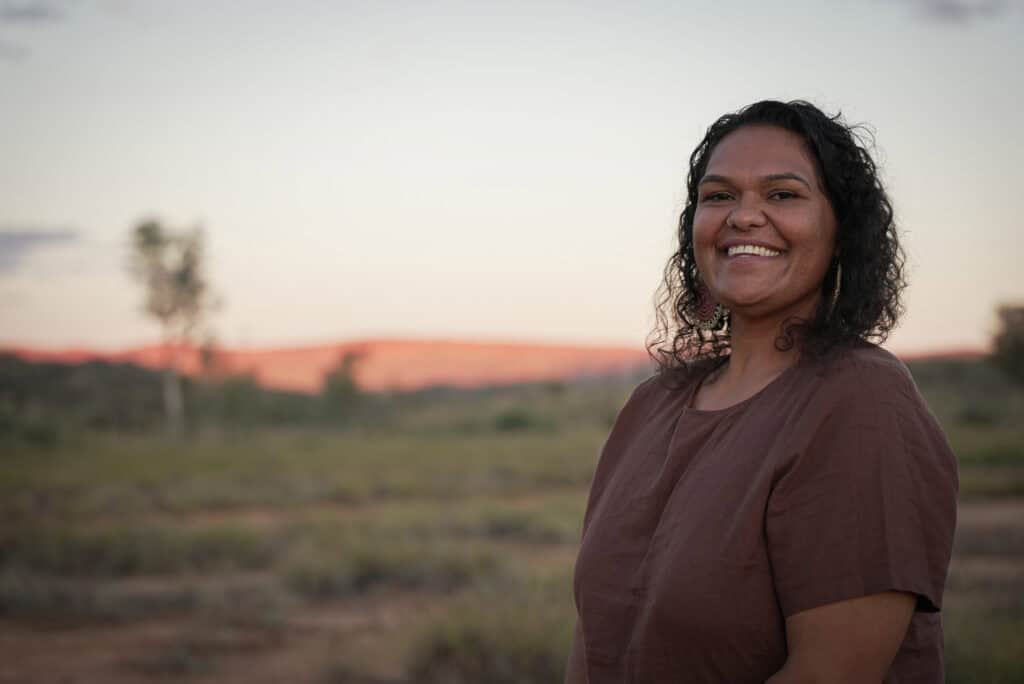
Claire Delahunty: Cherisse, could you please introduce yourself?
Cherisse Buzzacott: I’m an Arrernte woman from Alice Springs or Mparntwe. I’m a mum of three boys. I’ve got one girl living in memory and my three boys are Dylan, Douglas and Angus, and my partner. We live out west of Alice Springs on my traditional homelands. I’ve been a midwife for the last 11 or 12 years. And I’ve been able to work in different communities around urban and remote settings and mostly in Alice Springs. I do a lot of work in the advocacy space and around Birthing on Country and providing equitable access for First Nations women and birthing people in maternity care. But I’m moving more broadly into working with Our Mob in how we can look into different ventures and businesses. I’m working at the Northern Territory Indigenous Business Network as a senior policy officer. I have a consultancy of my own, so it’s quite natural for me to be able to contribute and support Black businesses to be able to thrive.
I sit on a Rodanthe Lipsett Indigenous Midwifery Charitable Fund. We give scholarships to First Nations students and midwives. I sit on a number of different advisory committees nationally and locally. I do a lot of work around stillbirth and miscarriage and infertility because that’s been a big part of my own personal journey.
CD: When did you know that you wanted to work in the birth space?
CB: I was in year nine at school, we got introduced to different university courses. I heard a little bit about midwifery and I thought, wow, I’m going to go work with mums and babies. It’s going to be such a fulfilling job, that I can work with my community. It wasn’t really until I got a little bit older that I kind of realised what midwifery was. And I really wanted to go into that space because I thought I’ve really got an interest to work with mothers and babies and that sort of start of life, how can I help in that area? Midwives work in a space of holistic care where they’re looking at the person, at all aspects of their life. And that’s very much the way our culture is. As an Aboriginal person, that’s how I look at everything through a cultural lens. And through that, we look at how everything’s connected. So for me, it just felt like a really natural transition coming into that midwifery. And I just love the rewarding feeling I have of seeing women and babies and now babies are growing up to be children and still even now have connection with women that I supported them at their birth or through their pregnancy.
CD: Was there a shift for you, seeing that there were issues with the system itself with the equity of care?
CB: That was almost immediate as a student midwife, walking around the hospital and just seeing the differences in the quality of care that Aboriginal women were receiving; the racist comments; there were jokes about Aboriginal women. And this was happening for me as a student. You’re very much powerless …
I started to see it and being able to call it out. Once I felt like I’ve set in my place, now I know what I’m talking about and having ownership of that. No one can take that experience away from what that woman that is having, you know, racism or discrimination enacted on them.
CD: Do you mind talking a bit about what culturally safe maternity care looks like and what you’ve done in the Birthing on Country space?
CB: I was really lucky to get an opportunity to work in Birthing on Country. I was a midwife working back home in Alice Springs and there was an opportunity to move away to Canberra, live there and work for the Australian College of Midwives. That was a really big transition for me. But I just get into things; that’s how I ended up in this ARLP 31 cohort – I have my mind set on something and that’s what I want to do. I got to work alongside peak bodies of health; worked with the Congress of Aboriginal and Torres Strait Islander Nurses and Midwives (CATSINaM). They were doing a lot of work with regulation bodies around cultural safety – putting that into our codes of conduct as midwives and nurses.
Cultural safety has to be determined by the recipient of the care. It means a carer coming to you person-to-person and providing a care without judgment, without bias.
I didn’t set out to be the ‘expert of cultural safety’, but being one of the only Aboriginal midwives in the space … for me, it was calling out the systems because it really is the systems and the structures that have been set up that mean there is a privilege for some people that disadvantages others … It’s all around systems change.
CD: What do you think gives you the inner conviction and the confidence that you’ve had through your career?
CB: I think it’s come through my family, and I don’t know if it’s because I’m the oldest daughter; oldest granddaughter, that sort of thing. I’ve got a long line of advocates in my family that push to live on Country and they marched the streets. It’s all around being unapologetically black and making sure that … if you see something and you want to challenge it, you go ahead and challenge it.
I almost accidentally became this expert on Birthing on Country and First Nations midwifery care and remote communities. I think for me it was, there was no one else that was gonna stand up and do the work and I was willing to do it.
CD: Where are we at with Birthing on Country and with political acknowledgement that it’s something that’s really important and needs to be invested in?
CB: Really big movements happened in the last 12 to 24 months. Waminda, the South Coast Aboriginal Women’s Welfare Corporation over in Nowra, they received some funding to put together their Birthing on Country facility. They’ve now got their Birthing on Country agreement with the hospital there where their midwives are able to go up and practice in the hospital and they’re employed through the women’s Aboriginal corporation. So there are really big movements happening. I guess the different policies that are coming out in support of more midwives practicing autonomously so that we don’t have to be in hospitals. But noting that Birthing on Country is different to home birth because there’s a whole cultural aspect of Birthing on Country.
There’s some good literary evidence already written – and definitely looking at the Indigenous models that are happening overseas in First Nations Canada. They’ve been Birthing on Country up there for nearly 20 years and they’re showing really good results. It’s moving slowly, but before it was something that was definitely out of reach. But it took a long time to get to this place where we are. There’s already acknowledgement of Birthing on Country. It’s being spoken about by health ministers and it’s being spoken on a local level, and at state and federal.
CD: Do you mind speaking to whatever level you’re comfortable with, about your own experience of unsafe care and sharing your story through the internationally acclaimed documentary, Birth Time?
CB: I got introduced to Birth Time through the Birthing on Country project, and the team came out and met with us down in Nowra. They came out to Alice and at that point I’d been less than a year on from having my daughter, Senna, and having had an experience that was for me highly traumatic. I’d already been a midwife for a few years. So just the feeling of all of this work that had come undone in that moment of me having my daughter and being treated the way that I was. It felt like, ‘what have I done? What have I achieved? I haven’t advanced anything because, you know, here I am: I’m an Aboriginal woman, but I’m a midwife and I know …’ That’s when I started to open up more and I started to see that the story resonated with people. Not only Mob, but all women came forward and said ‘look, I’ve had a similar situation’. I’ve written about it in The Guardian. Being able to tell it on camera, there’s always a good feeling when you can openly speak on something. At that point, when it aired, I had had my son. It was a little bit of a celebration for me to be able to share that at the end of the story that I’ve had Angus.
I’ve had miscarriage after miscarriage. I’d had my daughter … I was about on 20 weeks pregnant. I was over the ‘safety point’. I think I only recently just shared the information that I was pregnant within that week before I went into early labour and I developed an infection and had my daughter a couple of days later. We received brilliant care once my daughter was born … [but] I’d been doing some research around Birthing on Country, so I was hearing from stories of different Aboriginal women that had basically died from negligent care and some women that were pregnant and some that had lost babies and hearing that they were denied 100% care because they were Aboriginal and then that was happening to me … my partner was there and he very much didn’t want to be branded that sort of ‘angry black man’. He was very quiet, he didn’t speak, he didn’t say anything. He kind of witnessed everything but felt powerless to speak, which is what that medical system does to us and very much it’s a power imbalance. Then I called my midwife friend who is an older Caucasian lady, she came and she was my voice, then she was my advocate and she stayed with me the majority of the time and she spoke for me and she spoke to me and allowed me to be seen and allowed me to be heard. I shudder to think what could have happened if she wasn’t there and the type of experience that we might have had if she wasn’t present and I’m so forever indebted to her because it makes all of that difference to have somebody who can advocate for you. After that experience, I was going 100 % for our community’s women.
CD: Did you feel anger after that experience?
CB: I was angry at the system. I was angry for me. I was angry at my fellow health professionals. I was angry at doctors. I was angry at midwives. I was angry at the denial of the of what happened … That’s what pushed me. Things need to change because women are dying, babies are dying and children are going without proper care, all because of the colour of their skin in most situations, but also the system itself is not set up to support women and birthing people. That was my push, that was my drive.
CD: And at what point were you interested in doing some leadership development in a formal sense?
CB: I participated in a Straight Talk program, which is a political program for First Nations women across Australia. You come and spend five or six days together in Canberra learning about the political system. I definitely am political by birth, being Aboriginal; being a woman; being a midwife; it’s a very political profession.
I started to see more and more people from that program become engaged in the Australian Rural Leadership Foundation programs. One of the facilitators on one of your programs was Michelle De Jong. I linked up with her, as she facilitates Straight Talk. We’ve always maintained contact, and then just seeing her growth and her leadership … And then coming into hearing about Milparanga, I knew that Michelle and others were involved. And so I was like, I’ve got to do it. I’ve done a lot of different programs and there’s nothing really that’s grabbed me as much as Milparanga did last year. It was such an experience for me. It just kept me wanting more. My best friend had applied for the ARLP last year and got in but then she stepped back because, you know busy mum, busy work. She said ‘you should apply’ and I was wanting something more. I’m constantly being challenged in my personal life, in my professional life and I feel like having these experiences it instils in me more confidence. I came out of Milparanga last year and I was just on this high. I came to the realisation that I wasn’t happy where I was and made a decision to slowly transition out of the health space I was working in. For me, it triggered a lot of changes. You know, I don’t think you can ever get to a final, you know, you can’t get to be a final leader. You know, you don’t get to that end stage where you’re like, okay, you’re the ultimate leader now, you know, it’s a growth because the situation, the circumstances, the society that we live in is constantly changing. So there’s constantly new challenges coming up. And so for me, it is that continuous journey. For me, it doesn’t stop.
CD: What are you hoping to build on or discover through doing course 31 of the ARLP?
CB: I feel like I’m ready to be challenged again. I think this will definitely be challenging in terms of my way of thinking and noting that I’m going to be in a group of people that I don’t know and people that will have differing opinions to me. And I loved that in Milparanga, I loved that, that we all came together, we all had different opinions, we’d had different experiences, and we challenged each other.
I feel like challenging each other and then coming out with … you’re not coming to a resolution, because you’re never going to a hundred percent agree, but you might’ve shared an idea with someone and they might’ve shared something with you. Eventually it might sway their thinking. I’m open to it all. I’m just ready to receive anything that comes my way.
CD: Are you carrying some aims about what you would like to communicate about your community and perhaps return and do back home through this leadership development?
CB: I definitely want to get in and change a few minds and give a perspective of someone who’s a local. I’m an Arrernte woman. I grew up in Alice Springs; I’m very much connected with different levels of the community; different layers. As a midwife I’ve been exposed to a lot of different people from remote areas that come into Alice Springs that are sometimes at the centre of all of the disputes and things that happen. I really want to just openly share my experience. Hopefully people can take some of that away when they go back home and see Alice Springs on the news.
I feel like we put a lot of attention into the quick-fix band-aid solutions rather than looking at the long term. If we keep focusing on the deficits; if we keep focusing on the weaknesses and we keep pushing the ideology of that Aboriginal people are violent; that Aboriginal men are violent; that we’re alcoholics; that we don’t know how to keep a job; we don’t know how to get a licence. How do we get out of that mindset? I get that a lot of people are feeling unsafe, but there are a lot of people in Darwin, in Townsville, in Mount Isa, in Sydney, and in other places that are feeling really unsafe as well. Our current generation is so young. We’ve got this large group of young people across Australia that nothing’s been put in place for them. There’s really nothing for them to aspire to be. There’s been no progress. There’s been no work laid down to be able to actually support our young people to succeed.
CD: Are you conscious of protecting yourself from burnout and from that massive load of always being the one called on to speak. How do you navigate that?
CB: It’s been a funny sort of journey, like a roller coaster, because in the you kind of get thrown into it and accept it. Then as I’ve progressed more and I’ve gotten older I feel like I’m getting strong in my space to be able to say, well, actually, no, maybe I’m not the right person. If people want to come to Alice Springs and speak to an Arrernte person first and foremost, then they would come and speak to an Elder. I’m by no means an Elder. So for me I look to my old people and say, you know, there’s an opportunity to do some speaking or to speak out against this issue.
Most of the time they’re very willing to allow me to do it. I’ve grown into being able to go back to my community and say, I don’t think I’m the right person. And even in the midwifery space, I now have this amazing network of black midwives that I can come back and go, there’s an opportunity here to be part of this advisory group or to be a part of this paper – I’m not the right person for it. You know, who else can we look at? And we can identify very quickly someone who has the ability and someone who has got the knowledge to take it on.
I definitely have been learning to say ‘no’ to a lot of things. And knowing that also for us as Aboriginal people that we are doing a lot of the work that we don’t need to be doing. A lot of the time we do get called upon as Aboriginal people to fix a lot of the issues, but we’re not part of the solution and we weren’t part of the original problem. It’s kind of like the systems change thing – it’s a system that’s been thrust onto us that we have to participate in, but it’s definitely not within the way that we operate.
CD: What does your role with the National NAIDOC Committee mean to you?
CB: That’s our celebration … we go all out. We just get to celebrate us and feel good in our practices and in our knowledge and our skills and put it on show for each other and it’s on show for the public, and I love that.
I wanted to be part of NAIDOC because I marched as a little kid. Part of NAIDOC is a celebration for us, but it’s also a protest.
Definitely this year’s theme – keep the fire burning, Black loud and proud, coming off the referendum last year … this is such an opportunity to say, well, the ‘Yes’ vote didn’t get up like it should have. So the ‘keep the fire burning’ means we will continue. We don’t need any sort of government legislation to say, ‘well, now you have a voice’. We already have that. We are in that time of being unapologetically Black and we can come out and celebrate our culture and our kids can be strong in language and strong in feeling their connection and their identity. At the end of the day, nothing can erase that. I feel like this year’s theme is so powerful, and I really want to shout out to the National NAIDOC committee for all the amazing work that they do. I feel pride all around.
CD: What are some of your bigger aims as you chart out the years leading towards you being an Elder and embodying that leadership phase of your life that will come down the track?
CB: Once I’m done with ARLP, I think I want to really jump back into uni. I’m not sure what yet, but I did start my MBA a few years ago. I’m going to take a little bit of a pause on that advocacy level. All of the national work that I’m doing at the moment, I really want to pull back on. I’m going to start handing over slowly before the end of this year, a lot of the projects that I’m working on. I really want to focus more locally. I participated in the ‘politics pathways for women’ recently. I’m really interested to get into that space. I’ve always had political aspirations. I’m looking more around local council. I want to just be more involved locally with what’s happening there at that level. Potentially I could move into Territory or federal government.
After the ARLP, I really want to just take a couple of years to focus on my consultancy, supporting the black businesses. I really love this space at the moment because I’m seeing the growth and the financial wellbeing for Our Mob … supporting those businesses to thrive – and then having that time with my kids and jumping into the next challenge, whatever presents itself.
If any of this content has raised something for you, please seek support:
Lifeline: call 13 11 14 | text 0477 13 11 14 | https://www.lifeline.org.au/
To catch the full interview, head to the Rural Leadership Unearthed podcast website.
To find out more about the impact Cherisse is having in her community and more broadly, connect with her on LinkedIn.


